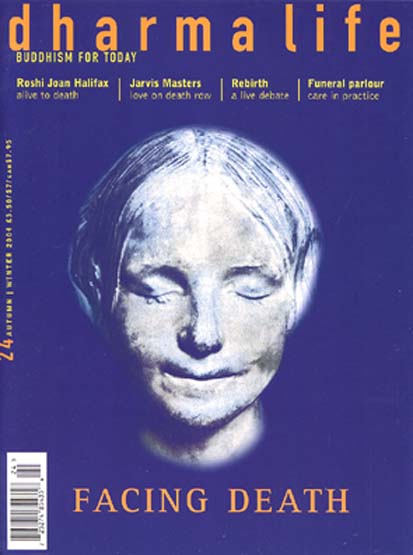The Dance of 17 Lives
The Incredible True Story of Tibet's 17th Karmapa
Mick Brown
Bloomsbury 2004, $25.95/£16.99 h/b
The charismatic 16th Karmapa Rangjung Rigpe Dorje died on November 5th 1981 and thereby set in train events that have shaken the world of Tibetan Buddhism. These events culminated in the enthronement in 1992 of Orgyen Trinlay Dorje as the successor to the Karmapa, and the young Karmapa's eventual escape to India in January 2000. With his accession to the Karmapa's throne, Orgyen Trinlay Dorje became the overall head of the powerful Karma Kagyu school of Tibetan Buddhism.
The Karmapa Lamas are the oldest continual line of reincarnate lamas or tulkus in Tibet, with a lineage stretching back to the 12th century ce. Like the Dalai Lamas, the Karmapa Lamas are considered to be re-incarnations of the Bodhisattva Avalokiteshvara, and thereby represent the activity of compassion in the world. The term Kar ma pa in Tibetan means 'man of action' or 'he who has mastered karma'.
What made the events surrounding the enthronement of the 17th Karmapa so unusual, and what led to political machinations and intrigue of positively medieval proportions, was that there was not just one contender for the throne of the 16th, but two. Both contenders were represented by rival factions who were out to get their candidate recognised as the 'true' incarnation of the 16th Karmapa. The 'alternative' to Orgyen Trinlay Dorje was Thaye Dorje, who was supported by the authoritative voice of Shamar Rinpoche. Previous Shamar incarnations were no strangers to political intrigue - the line of succession of the Shamar Lamas had been banned for 250 years by the Tibetan government for political machinations against the state by the 10th Shamar Rinpoche.
Accusation and counter-accusation issued from both parties engaged in the debate, a debate that became increasingly bitter as time progressed. Much of the acrimony was centred on the authenticity of the 'letter' that is traditionally left by the previous incarnation predicting where the next incarnation will be found. Eventually the Dalai Lama was called upon to adjudicate and give his seal of approval to Orgyen Trinlay Dorje. This 'approval' was eventually given in July 1992. However, the Dalai Lama himself did not escape unscathed: he was heavily criticised by some for his intervention in Karma Kagyu politics.
Mick Brown in his book The Dance of 17 Lives sheds a great deal of light on the murky world of Tibetan spiritual politics through a series of interviews with the main protagonists. The book is written in a heavily journalistic and mildly sensationalist style that has the beneficial effect of drawing the reader immediately into the world of which the author is writing. From this perspective The Dance of 17 Lives can be considered a 'good read', to be perused at bedtime or on holiday. However, those looking for more scholarly fare will be disappointed by the book's 'gossipy' interest in the fledgling Tibetan Buddhist communities of the West in the 1960s and '70s. This trait is particularly exemplified in the chapter entitled 'You Can Never Be Selfish Again', which documents and savours some of the already well-known proclivities of the late Tibetan teacher Chogyam Trungpa.
Having said this, the book offers a real glimpse into the Tibetan world. Tis is a world that bears more than a passing resemblance to the world of medieval Europe, with its emphasis on divination, omens and miracles. Through his interviews Brown allows those that inhabit this world to speak and thus demonstrate the internal logic of this world. This logic, with its reliance on prophecy and miracle, will appear strange and even alien to contemporary western eyes, but the author never questions it. However, Brown's consistent extension of the 'principle of charity' to his interviewees is commendable, for he rarely lets a voice of censure enter his reporting of what he is told.
What comes across clearly throughout is Brown's intense admiration for the figure of the 17th Karmapa, Orgyen Trinlay Dorje, and the way he has coped with the enormous pressures placed upon him from a very young age. Rather than idealising the figure of the Karmapa, however, Brown sees him as both isolated and vulnerable. Despite the isolation and intrigues, this young man, Brown suggests, has acted with great dignity.
While this book may not appeal to scholars of Tibetan Buddhism or Tibetan culture, its value lies in demythologising this culture for a general readership. Brown demonstrates how spiritual and secular power are intimately related in the world of Tibetan Buddhism, with many monks and lamas jostling for the power that comes with spiritual authority. Tibet and Tibetan Buddhism continues to exert a strong influence on the western imagination and this book acts as a useful corrective to the more 'romantic' elements of that imagination.
John Peacock is director of Sharpham College for Buddhist Studies and Contemporary Inquiry, UK



